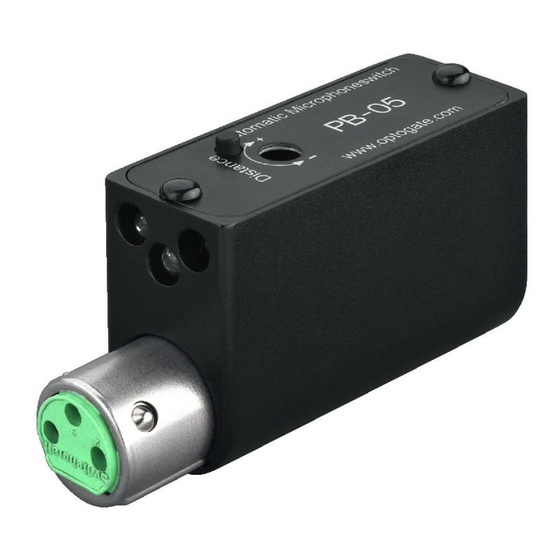
Advertisement
Quick Links
User manual for the Optogate models PB-05 / PB-06 / PB-07
revised 17/10/11
No time for manuals? No problem, this will take only 3 minutes of your time to read it and you will have more fun and
success with your new Optogate device. The Optogates were designed for professional applications and to be used
by experienced sound engineers and technicians only.
The PB-05 are available in 2 versions: PB-05 Dynamic Ducker with –16dB attenuation and PB-05 Mute with –42 dB
attenuation in "Off" position. The Dynamic Ducker version has a small "D" on the faceplate engraved.
The Optogates work with 48V phantom power. Just switch on the 48V on the console and the Optogate is active. The
phantom power passes through the Optogate to the microphone. If you use dynamic mics you can "remote control"
the unit with the phantom power switch. The microphone is switched on when the phantom power is switched off.
Before turning on or off the phantom power please mute the channel in order to prevent switching noise.
The PB-05 has a small switch on the faceplate. This gives the user the advantage to switch between the
"Optogate enable" and " Mic on" (or bypass mode) function. One push on the button will switch on the mic.
One more push will enable again the Optogate gain reduction function. The Optogate function is enabled
when the phantom power is switched on, regardless, what function was active before. So, the engineer can
reset the PB-05 to the "Optogate enable" function by switching off the phantom power for at least 3 seconds
if the performer forgot to enable it.
You have already found 3 LED devices on one side. The middle device is a red status LED. It indicates if somebody is
in front of the unit and the microphone is switched on. The outer LED's are the infrared transmitter and the receiver.
The transmitter will send 16 pulses per second if the phantom power is switched on. The Optogate will switch the mic
on if there is any signal reflected from a surface back to the receiver.
The distance from the mic to the performer in which the unit opens and closes is adjustable with the help of a 12-turn
spindle potentiometer inside. On all units the distance will increase by turning the pot to the right for a maximum
distance of about 4 feet and will decrease the distance by turning the pot to the left. Please be aware that some dark
materials are not able to reflect infrared signals back very well, which in turn might decrease the distance. Please
experiment with the potentiometer to fine-tune the distance together with the performer before using live. It also would
be helpful to have your show lighting active while adjusting. The width of the sensor is about 15 degrees wide from the
unit. The mic will be switched off if the artist moves out of this angle.
When you turn the pot to the left eventually you will hear a light click of a spring. You cannot overturn the pot. You are
now at the shortest distance range. When you start to turn the pot clockwise, you will find that the distance range will
change very slowly in the first few turns. After a few turns, the distance will change more rapidly until you reach the
maximum range. If you turn the potentiometer clockwise (right) out of the useable area, the mic will be
switched on completely. If this happens, just turn the pot slightly to the left until the Optogate works again.
We suggest that the engineer work with each performer to explain the operation of the unit and then set the range of
the Optogate to fit his or her mic technique and stage set-up. As a rule the closer the performer is to the mic, the
better the results will be due to eliminating the concert lighting variables.
The Optogates work well with dynamic mics and condenser mics up to 10 mA. You may find out that the switch off
time of the indicator led can be a bit different from the real audio switch time depending of the mic type. A small pwm
routine in the Optogate is responsible for it in order to prevent switching noise. The spindle pot will cover a wide range
of mics. The distance range of the Optogate can change a bit when the ambient light changes. Like every other
infrared device on the market the Optogate units do not work correctly if direct sunlight or other very high power
infrared signals hits the sensor. That is in the "nature" of the infrared technology due to the random high power
infrared spectrum in the sunlight. You can try it with your remote control of your home sound system. No infrared
sensor of CD-players, TV's etc. will work in direct sunlight. If direct sunlight hits the sensor the Optogate will be
triggered and the mic will be "on". The unit will work again if somebody moves between the sun and the sensor.
Normally you can use the Optogates on almost every open-air stage without any problems. It is always a good idea to
check the range of your Optogates when changing venues, especially outdoors with direct sunlight.
Advertisement

Summary of Contents for OPTOGATE PB-05
- Page 1 We suggest that the engineer work with each performer to explain the operation of the unit and then set the range of the Optogate to fit his or her mic technique and stage set-up. As a rule the closer the performer is to the mic, the better the results will be due to eliminating the concert lighting variables.
- Page 2 3. Click the bypass switch on top of all of the Optogates you are using and dial in the PA for the best tone and gain before feedback with the optogate bypassed …ie. mics are on, light stays on no matter where you are physically) 4.
